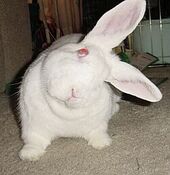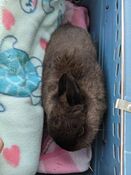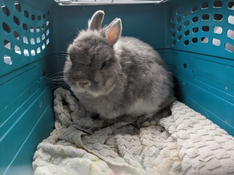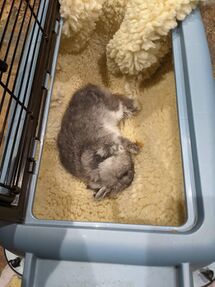Head tilt
Head tilt is a condition in rabbits also known as wry neck or vestibular disease where the ear is held downward toward the ground and maintained in a position other than normal. The vestibular system coordinates position and movement of the head, and when a disease affects this system, it most consistently results in head tilt.[1] Another term often used is torticollis, meaning that the neck muscles are contracted; however, this is a consequence of the condition and not the cause. It may also be referred to as otitis media (middle ear infection) or otitis interna or labyrynthitis (inner ear inflammation).
Symptoms
- Has a head position ranging from a few degrees to 180 degrees from the normal position.

- Unable to keep balance to stand (ataxia).
- Falls or leans to one side.
- Rolls and spins over onto side.
- Chases tail round in a circle.
- Body is curled or twisted, with one eye predominately facing upwards and one to the ground.
Causes
Causes of head tilt can be divided into peripheral (not involving the brain) and central (involving the brain).
Head tilt is commonly caused by the following:[1][2]
- bacterial inner or middle ear infection
- Encephalitozoon cuniculi infection
- trauma
- spontaneous vestibular disease (e.g. ascending Pasteurella multocida from nasal cavity via eustachian tube or abscesses along vestibular tract)
- cancer
- toxoplasmosis
Lop-eared rabbits are more prone to ear infections, while dwarf breeds, older and immunosuppressed rabbits may be more predisposed to signs due to infection with E. cuniculi.[1]
Head tilt can also be caused by Baylisascaris larva. Rabbits may ingest hay, bedding, or other material that has been contaminated with raccoon feces.[2]
In pet rabbits in the UK, the two main causes of vestibular disease are pasteurellosis and E. cuniculi infection.[2]
Treatment
For head tilt due to an ear infection, antibiotics will be prescribed after a culture & sensitivity test. Depending on severity, long-term antibiotic treatment may be necessary, on the order of 4-6 weeks minimum to several months.[1] Broad-spectrum oral antibiotics used to treat the condition include enrofloxacin (Baytril), marbofloxacin (Zeniquin), and trimethoprim-sulfa (Tribrissen, Septra, Bactrim, Cotrim, Sulfatrim).[1] If anaerobic infections are suspected, oral drug treatments include chloramphenicol (Chloromycetin, CHPC) or azithromycin (Zithromax) which can be used either alone or combined with metronidazole (Flagyl).[1] Be careful with prolonged high-dose metronidazole as it can be potentially toxic to the vestibular system.[1] For injection drugs, treatments include penicillin, penicillin G benzathine, or penicillin G procaine.[1] Remember, penicillin-type drugs should never be prescribed as an oral drug as it can cause fatal enteric dysbiosis and enterotoxemia.[1]
For head tilt due to E. cuniculi, see the article page for more information.
Severe vestibular signs such as continuous rolling or torticollis and seizures may be treated with diazepam (Valium) or midazolam (Versed).[1]
Meclizine (Bonine, Antivert, Meclizine Hydrochloride) is also a drug that may be prescribed to reduce nausea and induce mild sedation.[1]
See the following videos for some sample exercises that can be done for head tilt rabbits to help them regain their balance and neck support:
- Friends of Unwanted Rabbits. (2021). Video of exercise for Bambi with head tilt
Online support communities
The following are some online communities that specialize in helping disabled rabbits and rabbits with head tilt.
- Facebook, Help for Head Tilt Hoppers (Private group)
- Facebook, Disabled Rabbits (Private group)
- Facebook, On the Wonk (Public group)
Experiences
The following are some stories and social media pages of rabbits with head tilt.
- Molly Varga Smith, BVetMed, DZooMed, MRCVS. (2021). Head Tilt in a Rabbit [PDF]
- Facebook, Hope for Cordelia (RIP)
- Instagram, ginnyrabbit. (RIP)
- Ringo's Bunny Blog. (2016). An Interview with @ginnyrabbit.
- Instagram, thebunnynamedhiphop. (RIP)
- Kar Is. (2017). Facebook post on New Jersey House Rabbit Society page
- Jennifer Habernal. (2016). Head Tilt
- Bunnington Post. (2014). Bouffe Exclusive: My Headtilt Story.
- Bunnington Post. (2015). Rabbitting on with a headtilt.
- Lisa. Saving Siouxsie
- On the Wonk. (2012). Peanut
- Alicia Maria Rosa-Perrotti. (2011). Special-Needs Rabbits: Working with Headtilt
- Mary Kate Costello. (2009). Sadie’s Story
- Katy Hill. (2006). Lara (Detailed Diary)
- Laurie Conti. (2001). Jillian’s Head Tilt
Further reading
- Christal Pollock, DVM, DABVP. (2016). Presenting problem: Head Tilt and Rolling in Rabbits
- Sandi Ackerman. (2013). Head Tilt: Causes and Treatment
- DisabledRabbits.com. Head Tilt in Rabbits
- PetCoach. Head Tilt (Wry Neck) in Rabbits: Causes & Treatment
- Special Bunny. How to care for a rabbit with head tilt
- Dana Krempels. Head Tilt (Torticollis) in Rabbits: Don't Give Up
- Jacqueline Warner, DVM. (2008). Head Tilt in Rabbits
- Susan A. Brown, DVM. (2006). Head Tilt in House Rabbits




